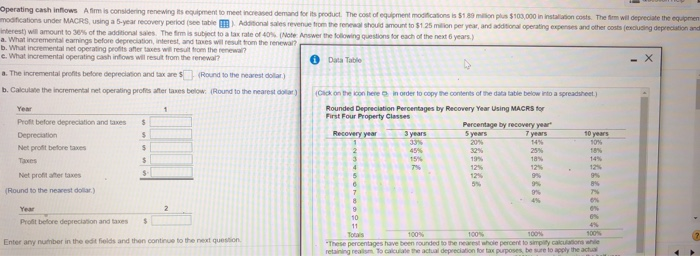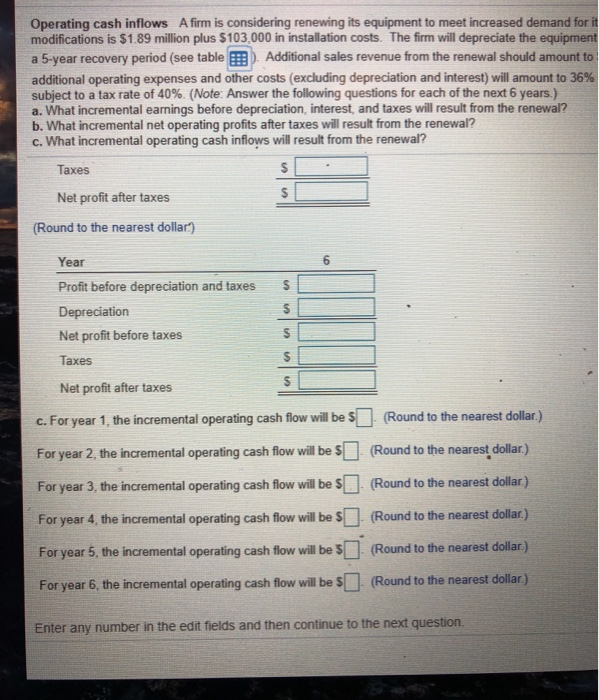Operating cash inflows Afirm is considering renewing its equipment to meet increased demand for its product. The cost of equipment modifications is $180 min plus $103.000 in instalacion costs. The firm will depreciate the equipmen modifications under MACRS, using a 5-year recovery period s tabiem Additional sales revenue from there should amount to $125 million per year, and additional operating expenses and other costs excluding depreciation and interest will amount to 30% of the additional sales. The firm is subject to a tax rate of 40% (Note: Answer the following questions for each of the next 6 years) a. What incremental earnings before depreciation, interest and tes will result from the renewal? b. What incremental net operating profits after taxes will result from the renewall? c. What incremental operating casinows wil rest from the renewal? Data Table a. The incremental profits before depreciation and tax are $ (Round to the nearest dollar) b. Calculate the incrementalne operating profits after taxes below. (Round to the nearest ) S Profit before depreciation and taxes Deprecation Net profit before taxes Clok on the one in order to copy the contents of the datatable below into a spreadsheet) Rounded Depreciation Percentages by Recovery Year Using MACRS for First Four Property Classes Percentage by recovery year Recovery year 3 years 5 years 20% 32 2552 Net profiter taxes (Round to the nearest dollar) Year Profit before depreciation and taxes Enter any number in the edit fields and then continue to the next que 100% percentages have been founded to the nearest whe percent to simply a cas e great to calculate the actual depreciation for tax purposes, be sure to apply the actual Operating cash inflows A firm is considering renewing its equipment to meet increased dem modifications under MACRS, using a 5-year recovery period (see table B). Additional sales interest) will amount to 36% of the additional sales. The firm is subject to a tax rate of 40%. (NG a. What incremental earnings before depreciation, interest, and taxes will result from the renew b. What incremental net operating profits after taxes will result from the renewal? c. What incremental operating cash inflows will result from the renewal? Depreciation Net profit before taxes Taxes Net profit after taxes c. For year 1, the incremental operating cash flow will be $ . (Round to the nearest dollar.) For year 2, the incremental operating cash flow will be $ . (Round to the nearest dollar.) For year 3, the incremental operating cash flow will be $ . (Round to the nearest dollar.) For year 4, the incremental operating cash flow will be $ . (Round to the nearest dollar.) For year 5, the incremental operating cash flow will be $ . (Round to the nearest dollar.) For year 6, the incremental operating cash flow will be $ . (Round to the nearest dollar.) Operating cash inflows Afirm is considering renewing its equipment to meet increased demand for its product. The cost of equipment modifications is $1.89 million plus $103,000 in installation costs. The firm will depreciate the equipment modifications under MACRS, using a 5-year recovery period (see table ). Additional sales revenue from the renewal should amount to $125 million per year, and additional operating expenses and other costs (excluding depreciation and interest) will amount to 36% of the additional sales. The firm is subject to a tax rate of 40%. (Note: Answer the following questions for each of the next 6 years) a. What incremental earnings before depreciation, interest, and taxes will result from the renewal? b. What incremental net operating profits after taxes will result from the renewal? c. What incremental operating cash inflows will result from the renewal? a. The incremental profits before depreciation and tax are $ (Round to the nearest dollar.) b. Calculate the incremental net operating profits after taxes below (Round to the nearest dollar) Year Profit before depreciation and taxes Depreciation Net profit before taxes Taxes Net profit after taxes (Round to the nearest dollar) Year Profit before depreciation and taxes SL i Data Table in order to copy the contents of the data table below into a (Click on the icon here spreadsheet.) Rounded Depreciation Percentages by Recovery Year Using MACRS for First Four Property Classes Percentage by recovery year Recovery year 3 years 5 years 7 years 33% 20% 14% 45% 32% 25% 15% 19% 18% 12% 12% 12% 9% 9% 10 years 10% 18% 14% 12% CODAWN- 50 8% 11 6% 6% 6% 4% Totals 100% 100% 100% 100% *These percentages have been rounded to the nearest whole percent to simplify calculations while retaining realism. To calculate the actual depreciation for tax purposes, be sure to apply the actual unrounded percentages or directly apply double-declining balance (200%) depreciation using the Operating cash inflows A firm is considering renewing its equipment to meet increased demand for it modifications is $1.89 million plus $ 103,000 in installation costs. The firm will depreciate the equipment a 5-year recovery period (see table B . Additional sales revenue from the renewal should amount to additional operating expenses and other costs (excluding depreciation and interest) will amount to 36% subject to a tax rate of 40%. (Note: Answer the following questions for each of the next 6 years.) a. What incremental earnings before depreciation, interest, and taxes will result from the renewal? b. What incremental net operating profits after taxes will result from the renewal? c. What incremental operating cash inflows will result from the renewal? Taxes Net profit after taxes (Round to the nearest dollar) Year Profit before depreciation and taxes Depreciation Net profit before taxes Taxes nuo Net profit after taxes c. For year 1, the incremental operating cash flow will be 5 (Round to the nearest dollar.) For year 2, the incremental operating cash flow will be 5 . (Round to the nearest dollar.) For year 3, the incremental operating cash flow will be $ (Round to the nearest dollar) For year 4, the incremental operating cash flow will be $ (Round to the nearest dollar.) For year 5, the incremental operating cash flow will be 5 (Round to the nearest dollar.) For year 6, the incremental operating cash flow will be $). (Round to the nearest dollar) Enter any number in the edit fields and then continue to the next











